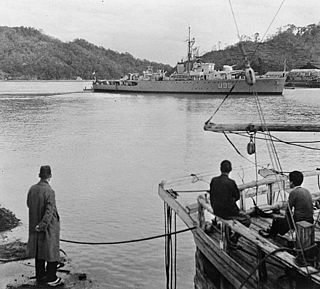A number of ships of the Royal Navy have borne the name Bombay, after the Indian city of Bombay, now Mumbai. Among them were:
There was also HMS Bombay Castle, a 74-gun third rate launched in 1782 and wrecked in 1796. She was ordered under the name Bombay in 1780, but was renamed before her launch.
Seven ships of the Royal Navy have been named HMS Prince of Wales, after numerous holders of the title the Prince of Wales.
Thirteen warships of the Royal Navy have been named HMS Revenge:

The Royal Indian Navy (RIN) was the naval force of British India and the Dominion of India. Along with the Presidency armies, later the Indian Army, and from 1932 the Indian Air Force, it was one of the Armed Forces of British India.
Six ships of the Royal Navy have been named HMS Amethyst, whilst another was planned:

Maritime powers in the Indian subcontinent have possessed navies for many centuries. Indian dynasties such as the Cholas used naval power to extend their influence overseas, particularly to Southeast Asia. The Marakkar Navy under Zamorins during 15th century and the Maratha Navy of the 17th and 18th centuries fought with rival Indian powers and European trading companies. The East India Company organised its own navy, which came to be as the Bombay Marine. With the establishment of the British Raj after the Indian Rebellion of 1857, the small navy was transformed into "His Majesty's Indian Navy", then "Her Majesty's Indian Marine", and finally the "Royal Indian Marine".
Ten ships of the Royal Navy have been named HMS Clyde after the River Clyde that runs through the city of Glasgow, Scotland. For Her Majesty's Naval Base Clyde see HMNB Clyde.
Five ships and two establishments of the Royal Navy, and one ship of the Royal Indian Navy have borne the name HMS Indus, after the Indus River:
Three ships of the Royal Navy have been named HMS Princess Charlotte, after either Charlotte, Princess Royal, daughter of George III, or Princess Charlotte Augusta of Wales, daughter of George IV:
Seven ships of the Royal Navy have borne the name HMS Alexander:

HMIS Bombay (J249), later INS Bombay, named for the city of Bombay in India, was one of 60 Bathurst class corvettes constructed during World War II and one of four operated by the Royal Indian Navy.

Several ships have been named after Bombay :

HCS Bombay, later HMS Bombay and HMS Ceylon, was a teak-built fifth rate, 38-gun wooden warship built in the Bombay Dockyard for the Honourable East India Company (HEIC) and launched in 1793. The Royal Navy purchased her in 1805 and renamed her HMS Bombay. She served with the Royal Navy under that name until 1 July 1808, when she became HMS Ceylon. She was sold at Malta in 1857 and broken up in 1861.
Eight ships of the Royal Navy have borne the name HMS Sparrow, after the sparrow:
Eleven ships of the Royal Navy have borne the name HMS Star or HMS Starr:
Thirty-nine vessels of the Royal Navy and its predecessors have borne the name Swallow, as has one dockyard craft, one naval vessel of the British East India Company, and at least two revenue cutters, all after the bird, the Swallow:
Eleven ships and a shore establishment of the Royal Navy have borne the name HMS Cormorant, after the seabird, the cormorant:
Nine ships of the Royal Navy have borne the name HMS Investigator. Another was planned, but renamed before being launched. The name Investigator passed on to the Royal Indian Navy and after India's Independence, to its successor the Indian Navy where the lineage of naming survey ships Investigator continues unbroken.

HMIS Sutlej (U95) was a modified Bittern-class sloop, later known as the Black Swan class, which served in the Royal Indian Navy (RIN) during World War II.
Several ships that have served the Royal Navy have borne the name HMS Madras for Madras: